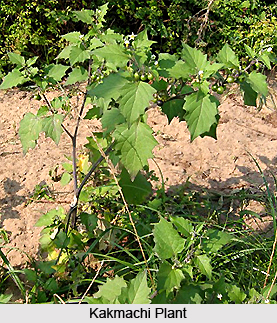 Kakmachi is a variable annual herb which is of high medicinal value. It is found widely throughout the tropical and warm temperate regions of the world. In India, Kakmachi is found throughout the country at an elevation of 2100 meters as a weed in open, disturbed habitats like cultivated lands, gardens and on roadsides. The botanical name of this herb is Solatium nigrum Mill. It is known by several names in different languages like Gurkamai and Tulidun in Bengali, Piludi in Gujarati, Karikaachi Gida in Kannada, Kakmachi, Kamoni, Ghati, Laghukavali and Meko in Marathi, Kakamachi and Kakamaci in Sanskrit, Kachchipundu, Kachi, Gajjuchettu, Kamanchi and Kasaka in Telugu, Kabaiya, Gurkamai and Makoi in Hindi, Manatakkali in Malayalam, Kambei, Mako, Kach-Mach and Riaungi in Punjabi, Manattakkali in Tamil and Makoya in Urdu.
Kakmachi is a variable annual herb which is of high medicinal value. It is found widely throughout the tropical and warm temperate regions of the world. In India, Kakmachi is found throughout the country at an elevation of 2100 meters as a weed in open, disturbed habitats like cultivated lands, gardens and on roadsides. The botanical name of this herb is Solatium nigrum Mill. It is known by several names in different languages like Gurkamai and Tulidun in Bengali, Piludi in Gujarati, Karikaachi Gida in Kannada, Kakmachi, Kamoni, Ghati, Laghukavali and Meko in Marathi, Kakamachi and Kakamaci in Sanskrit, Kachchipundu, Kachi, Gajjuchettu, Kamanchi and Kasaka in Telugu, Kabaiya, Gurkamai and Makoi in Hindi, Manatakkali in Malayalam, Kambei, Mako, Kach-Mach and Riaungi in Punjabi, Manattakkali in Tamil and Makoya in Urdu.
Kakmachi is an annual and a variable herb which is up to one meter in height with an erect, glabrous or sparsely pubescent stem and divaricated branching pattern. The leaves of this herb are 2.5 to 9 centimetres long and 2 to 5 centimetres wide, ovate or ovate-lanceolate, glabrous, thin, margins subentire to sinuately toothed, tapering into the petiole with apex subacute or acuminate. The petioles are 2 centimetres long. Flowers of Kakmachi are small, white in colour and are borne in drooping, umbellate 3 to 8-flowered cymes. The peduncles are 0.6 to 2 centimetres long and slender. The pedicels are 0.6 to 1 centimetres long and are very slender. The calyx is 3 millimetres long, 5-toothed, glabrous; corolla 2-8 mm long, divided more than halfway down into 5 oblong, subacute, reflexed lobes, stamens exposed, and yellow in colour. The Fruits (berries) of this herb are globose and are 5 to 8 millimetres in diameter. The fruits are red, yellow or purplish-black in colour when ripe. There are numerous seeds which are disc-shaped, 1.5 millimeters in diameter, yellow in colour and minutely pitted. The flowers and fruits are seen through out the year in the Kakmachi herb and are mainly seen between the months of February and July.
All parts of Kakmachi are considered demulcent, cardiotonic, alterative, antidiabetic, diuretic and laxative. The entire plant is used internally to relieve cardialgia and gripe. The fresh juice of the whole plant is used in the treatment of gonorrhoea, haemoptysis, dropsy, dysentery, piles, enlargement of the liver and spleen, and is regarded very effective in the treatment of cirrhosis of the liver; its decoction is considered narcotic and antispasmodic. The leaves and tender shoots of this Indian medicinal plant are boiled and eaten in many parts of India by patients suffering from dropsy. A decoction of the leaves is used as a laxative and diuretic. The warmed leaves are applied to relieve painful and swollen testicles; and the leaf paste is used as a poultice to provide relief from gout, skin diseases and rheumatic joints. The berries are regarded to possess tonic, diuretic and cathartic properties and are used in treating heart diseases and anasarca. They are a domestic remedy for fevers, eye troubles, diarrhoea and ulcers. A decoction of the berries and flowers is prescribed for relieving cold and cough. The ripe fruits are commonly eaten in pies and preserves.



















